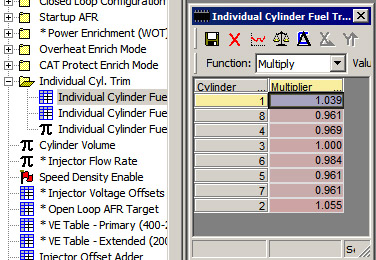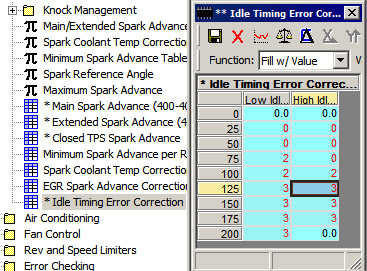Contents
Using EEHack Software
Experimentaton can be the best way of determining the best idle speed and timing advance, especially considering variance across different coolant temperatures.
The $EEHack software package that I maintain will allow you to test various timing advance, fueling, and idle speed modifications on the fly to find the most stable idle while the engine is running, and those changes can be easily committed to your tune.
Idle Fuel Trims
This allows you to take advantage of the sequential nature of the LT1 by adding or subtracting fuel from individual cylinders. The stock calibration tends to be grossly incorrect on an aged engine, or one which is heavily modified.
Tuning is simple, zero the table, and measure each cyl’s head temp with an infared temperature gun or reliable heat probe. Add a small amount of fuel to cylinders which read at a higher temperature, as they tend to be leaner than the others.
It will likely take several tries to get this right, and you will never get it perfect, but getting it closer will help.

Idle Timing
Base Timing
The LT1, in many configurations, seems to like a lot of timing at idle.
Experiment starting at 25 degrees of idle timing, and check MAP. Increase timing until you stop making more vacuum, then back off two degrees or so for safety. A feel of smoothness should also contribute.
After raising timing, decreasing values in the spark advance vs coolant temp table may also be necessary to avoid pushing it through the roof when the car is cold.
Idle speed based timing corrections
EE has a mechanism that makes fine timing adjustments in an attempt to stabilize idle rm errors, due to the fact that timing can make minor engine speed adjustments more quickly than the idle control valve.
On a car with a lighter rotating mass (such as an aluminum flywheel), or with quite a bit of natural idle surge from a cam, the stock corrections may be too extreme.
Typically anywhere from 50-150RPM of surge is normal for a larger cam or a light rotating mass, and trying to fight it can end up causing larger speed fluctuations and instability.
Try lowering them substantially to try to let the car idle more naturally. This is also reccommend if the base timing (above) was increased dramatically, as the stock settings may enter dangerous timing territory during a large RPM error.
For example, if a tune at 32 degrees @ 700 RPM idle drops to 500rpm, with the stock settings it would have 37 degrees of final timing, possibly with even more from the coolant temp adder table!
The following settings work well with an aluminum flywheel and a mild cam.

Idle BLM splits, and the idle passages
If you have tried all of the tricks in the headers and cam sections, as well as the individual fuel trims mentioned earlier in this section, and you find your BLMs are still split, you might have to give up and run open loop idle.
But first, one major cause of BLM splits at low RPM is insufficent feed through the idle ports in the intake manifold. Due to the length of the plenum, idle air is supposed to be drawn through a series of ports on the bottom of the manifold instead of through the plates to ensure even low RPM feed.
Ensure your IAC counts are fairly high (35+), by closing the throttle plates. If further adjustment isn’t possible, enlarging the bypass hole in the throttle body may be necessary. Some aftermarket throttle bodies don’t even have an idle hole, contributing to the problem.
Open Loop Idle
For substantially larger cams, dealing with corrupt o2 readings which tend to force a very lean idle may be impossible or undesireable. Not to mention, big cams really like to idle rich, and closed loop simply will not do it.
Even mild builds without catalytic converters may benefit from approx 14.1:1 instead of 14.7:1 idle, with a smoother idle, reduced temperatures while sitting in traffic, and less exhaust smell.
The LT1 doesn’t have open loop idle settings, however you can cheat using the PE tables.
Ensure PE activation around your idle speed happens at 0% TPS, and then use your low RPM PE table to affect idle fuel mixture. Remember there are two PE tables, rpm and temperature, make sure they both correspond to your desired settings.

Somewhere around 5% added fuel seems to be an appropriate starting point for most cams, but that depends how accurate your VE or MAF table is in the first place. Monitoring vacuum at idle, the smell of the exhaust, ‘feel’, and reading plugs may all help when trying to determine the ideal open loop idle afr.
A bit of experimentation may be required, as cold-start behavior may be a bit screwy. A great workaround is to split the PE TPS table into cold and hot, so PE idle only works when the engine is warmed up past a certain point, that way you can use the normal open loop routines until CL becomes active.
A patch for proper open loop idle is in the works.
